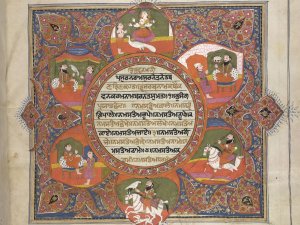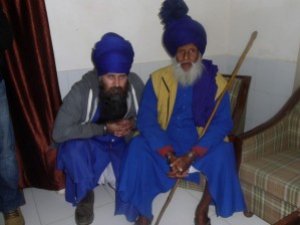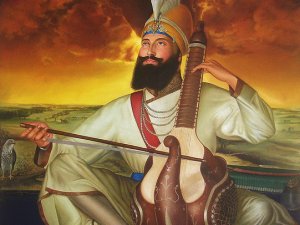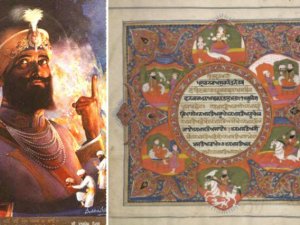AwrqI-Awrqw
Āratī-Āratā

What is Āratī-Āratā?
Āratī-Āratā is an evening prayer that is a part of the purātan nitnem of the Sikhs.1 Most Sikhs have heard of the Āratī of Guru Nanak and the Bhagats, but few have heard the full version that includes many inspiring verses by Guru Gobind Singh. The unedited version remains the preserve of the Akali Nihang Singh Khalsa. We can see that this composition gets its name from the verse by Guru Nanak:
Bv KMfnw qyrI AwrqI]
Bav KaVwanÁ terÅ ÁratÅ.
O Destroyer of Fear, this is Your lamp worship.
While the Āratā normally refers to the section by the Bhagats (Kanh Singh Nabha, 1932), in reference to the line by Bhagat Dhanna:
gopwl qyrw Awrqw]
gopÁl terÁ ÁratÁ
O Gopal, this is Your lamp worship.
Guru Gobind Singh also refers to the the term Āratī in his verses:
AwrqI kot krY sur suMdr pyK purMdr ky bil
jwvYN]
ÁratÅ koq karÄ sur suaVdar peK puraVdar ke bali jÁvÄ.
Millions of gods fully decorated, are performing Āratī and seeing the Lord, they show intense devotion.
The Āratī-Āratā contains the Gurbāṇī of Guru Nanak Dev, the Bhagats including Kabir, Namdev, Sain, and Dhanna, as well as the Gurbāṇī of Guru Gobind Singh. In modern times it has been edited to exclude a lot of the original verses added by Guru Gobind Singh. The Āratī-Āratā starts with Sri Dasam Granth Sahib bāṇī, then Guru Nanak’s Āratī, the Āratā of the Bhagats, then Adi Sri Guru Granth Sahib bāṇī, and ends with Sri Dasam Granth Sahib bāṇī. Normally it is sung in Kirtan after the Rahirās Sāhib. However, in the marayādā of Nanaksar, Namdhari, Udasi, Sewapanthi, Hazur Sahib, Patna Sahib, Akali Nihang Singh, a thāl with lamps is lit and offered by circumabmulating it in front of the Adi Sri Guru Granth Sahib. This marayādā is the original, as it was in the times of the Gurus. Those in the worship of the Adi Sri Guru Granth Sahib stand up while it happens, as it is like a prayer or devotion in front of the Guru for his love. Āratī-Āratā is performed on a metal platter (thāl) with ghee-lanterns (joti), incense (dhūp), and conch shells (sank).
What is its history?
It was during Guru Nanak Dev’s visit to the Jagannath Temple at Puri in 1506 AD that his Āratī was composed, where he stated that the whole universe is the Āratī to Vahiguru. Jagannath Temple is a famous pilgrimage center of the Hindus and even to this day non-Hindus are denied entry. Jagannath means ‘Lord’ (nāth) of the ‘Universe’ (Jagat), interestingly the English word juggernaught is from the same. Guru Nanak was mistaken as a Muslim, or due to the presence of Bhai Mardana, was not allowed into the Temple, so instead the Guru recited shabads on the sea shore of Puri. Jagannath appeared in the dream of the King of Puri and the golden platter for rituals in the temple, had disappeared due to Guru Nanak being refused entry. On meeting Guru Nanak the King was surprised to find Jagannath present when the Guru recited shabads. Guru Nanak was then escorted to the Temple with great reverence.2
On Guru Nanak’s visit he noticed that the priests were ritualistic rather than having love for God. The temple priests conducted an elaborate Āratī every evening. They brought a big platter on which were many ghee-lanterns, flowers, incense, and pearls, etc. They began the Āratī to the accompaniment of drums, cymbals, bells, and chanting from the scriptures. Guru Nanak was not only a great mystic but also a being full of Divine knowledge. The Guru would have been aware that this temple was originally dedicated to Paramātmā, as even the Hindus testify this Temple is dedicated to the Creator of the avatārs, but over the centuries it had degenerated to idolism.3 Those familiar with the Hindu Dharam will know its is a grave sin for Hindus to make an idol of Paramātmā, therefore the Guru was perplexed at seeing the idol of Lord Jagannath that attempting to symbolise the form of the Formless One.
While at the Jagannath Temple, Guru Nanak observed that the priests and devotees were ritualistic rather than having love for God. When the devotees stood up, like they do today, the Guru was filled with ectasy, transfixed, and so he remained seated. The Guru was was also said to be in deep thought when Āratī service of the idol was being performed. He was so overwhelmed that tears rolled down his eyes. Some Brahmins marked this indifference of Guru Nanak and took it as disrespect to Lord Jagannath. After the Āratī was over, they confronted him and asked him why he had not taken part in Āratī. They cast doubt on him being a holy man and they said to Guru Nanak that mere rosaries and a monastic garb do not make a monk. Guru Nanak stood there peacefully, as if nothing had happened. The priests persisted that he should explain his conduct, the Guru replied: ‘Dear brothers does Jagannath exist in this wooden image? Is God not splendid inside all creation? Can His greatness not be felt and experienced without idol worship?’
While uttering these words, Guru Nanak became highly devotional and spontaneously sang a hymn in Rāg Dhanāsarī, which is the melody of devotion, explaining that the whole nature was performing Āratī of God.4 Guru Nanak Dev sang the Āratī in his melodious voice, describing how the entire sky is the platter on which the sun and moon are the lanterns for worship. The stars and the planets are like gems and pearls, the sandalwood trees are the incense, and the wind blowing from all directions is the grand fan for the beloved ‒ ‘gagan mÄ TÁlu ravi chaVdu dÅpak bane tÁrikÁ maVwal janak motÅ.’ His singing reverberated around the whole Temple and touched the hearts of everyone. The priests realised that Guru Nanak was enlightened. We can see that the composition by Guru Nanak is actually about the idol made of the Lord, which perplexed him, this is also confirmed by the shabad stating ‘Lord you have a thousand eyes’ etc. This would explain why Guru Nanak sang the Āratī to the Pandits, to try and inspire them to follow the right path as it was accepted that this Temple was dedicated to the Creator and not deities.
According to B. B. Majumadar Guru Nanak spent time with Sri Chaitanya in Puri taking part in Kirtan.5 It is also said that Guru Nanak and Tulsidas met at this sacred site of pilgrimage.6 To this day a Gururdwara in Puri commemorates Guru Nanak’s visit to Puri. It is highly important to note that according to Akali Baba Santa Singh this is also where the Sarbloh Avatar manifested, who features in the Sri Sarabloh Granth Sahib. Please see later in this document about this. The Sikh King Ranjit Singh also made many donations to this Temple, and it is said he wished the valuable jewel Koh-i-noor to be donated to this temple, as recorded in his will.
The Āratī is further appended by the verses of Bhagat Ravidas who was a cobbler by profession. He too was a mystic and his writings have been included in Adi Sri Guru Granth Sahib. The following lines are the beginning of his works added to the Āratī: ‘nÁmu tero ÁratÅ majanu murÁre.
The Āratī was further enriched with the addition of the verses of Bhagat Sain, who too was a mystic saint of humble origins. He was a barber in the court of Raja Ram, the King of Reva. ‘What is the best Āratī or form of adoration of the Lord?’ is the theme of Sain’s verses incorporated in the Adi Sri Guru Granth Sahib. According to Sain singing of God’s praise and meditating constitute the highest worship. The following lines are the beginning of his works added to the Āratī: ‘suVn saVDiÁ terÅ dev devÁkar aDapati Ádi samÁÅ.’
Further verses were appended by Bhagat Dhanna, who was a simple Jatt farmer from Rajasthan from whose works are the famous lines that are beginning of his work, ‘Gopāl Terā Āratā.’
The Bhagats had also sung along similar lines before Guru Nanak, hence their inclusion into this composition. When the Guru ordered the Panth to take up shastras, the weapons were also venerated during the Āratī, this is called shastra pūjā. Then Guru Gobind Singh added vīr ras shabads to the Āratī, to make it both for the Saint and the Soldier, joining both Bhaktī and Shaktī. These shabads of the Tenth Master celebrate the victory of good over evil. Therefore, it is important to note that it was Guru Gobind Singh who finalised this compostion for the Khalsa. Therefore, the complete Āratī that is sung today has been composed by two Gurus, a cobbler, a barber, a weaver and a farmer. This is evidence that the Guru firmly believed in the equality of all of humankind.
When we read our nitnem in the morning we read Adi Sri Guru Granth Sahib and Dasam Granth Sahib bāṇī together. As the Khalsa is both a Saint and Solider, and requires Bhaktī and Shaktī. Similarly Āratī-Āratā is from mainly the Adi Sri Guru Granth Sahib, and Sri Dasam Granth Sahib and praises both the Divine-Masculine aspects of Vahiguru, as well as the Feminine-Divine aspects, and this is also reflected in its name. When we read the names of Indra, Chandi, Kalka in the composition the Guru is referring to Vahiguru’s power and glory, to defeat the demons, where the Guru refers to Vahiguru as the Divine Mother. It is not the worship of deities. The Guru also mentions a very important composition the Sri Brahm Kavach Sahib, and how this praise of the Divine Mother is like a current of water of the Ganges, i.e. amrit flowing into the Divine-ocean of Vahiguru.
Towards to end of the composition we find the verse by the Tenth Master,
This verse is actually found on the last folio of one of the oldest sarups of Sri Sarbloh Granth Sahib from 1698 AD. Therefore the Āratī-Āratā composition has the bāṇī of all three Granth Sahiban within it.
Click here for part 2 of Aarti Aartaa ~ Author's Viewpoint
Click Here To Read The Whole Aaratee Aarataa Bani
Biblio:
1 For more information about the nitnem see my other article at:
http://www.scribd.com/doc/130906016/The-History-of-the-Nitnem-B%C4%80%C5...
2 Tak, R. S.,‘Guru Nanak in Oriya Sources’, Sikh Review, 2012.
3 Patra, Avinash, Origin & Antiquity of the Cult of Lord Jagannath, University of Oxford, Weekly Journal, 2011.http://www.telegraphindia.com/1110703/jsp/orissa/story_14191119.jsp
4 Gandhi, S. S., History Of Sikh Gurus Retold 1469–1606 C.E., Vol. 1., Atlantic Publishers, 2007, p. 170.
5 Das, G.N, Reading from Bhagatbata. Abhinav Publications, 1996, p. 20.
6 S. S. Johar, University of Wisconsin--Madison Center for South Asian
Studies, Guru Tegh Bahadur. Abhinav Publications, 1975, p. 149.
==========================
References:
Bhai Gurdas, Vārāṅ.
Adi Sri Guru Granth Sahib
Sri Dasam Granth Sahib
Sri Sarbloh Granth Sahib
Bhai Bala Janam Sākhī
Tankhānāmah Bhai Nand Lal
http://www.akalinihang.blogspot.com
http://www.amritworld.com/pbi/commentary/hazooree_maryada/aarti_bare.pdf
http://www.dasam.info
http://www.kamalroopsingh.com
http://www.nihang.net
http://www.sarblohgranth.com
http://www.scribd.com/doc/130906016/The-History-of-the-Nitnem-B%C4%80%C5...
http://www.sikhnet.com/gurbani/artist/jathedar-baba-maan-singh-guru-nana...
www.searchgurbani.com
www.sikhitothemax.com
www.sridasam.com
http://www.sridasamgranthsahibji.com
http://www.telegraphindia.com/1110703/jsp/orissa/story_14191119.jsp
Anil Dhir, Odisha Review, The Jagannath Temple and the Sikh Arti, February - March - 2012.
C. Shackle, An Introduction to the Sacred Language of the Sikhs.
Das, G.N, Reading from Bhagatbata. Abhinav Publications, 1996.
Das, Suryanarayan, Jagannath Through the Ages, Sanbun Publishers, New Delhi, 2010.
Fakir Syed Waheeduddin: The Real Ranjit Singh, Punjabi University, 2001.





